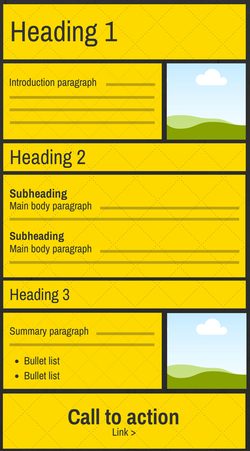It’s great you’re blogging, but how about getting it read? Wouldn’t that be nice?
The key to making content readable (apart from ditching words like ‘solution’) is a good structure. A recognisable hierarchy helps readers sort out what’s important, what they want to read and how this blog is going to work out for them – in other words, should they bother?
How your blog measures up from head to foot
The head
Your heading of course! The main title of the post, the thing that makes people think “Wow, that looks interesting.” Name your post as if it were a new-born child: with love, consideration and a few last-minute flights of fancy. It can always change it to Michael when it’s 18.
“On the average, five times as many people read the headline as read the body copy. When you have written your headline, you have spent eighty cents out of your dollar.”
David Ogilvy, the father of Advertising
The shoulders
It all rests on the shoulders: your introduction. The first few lines of your post are make or break. I like to start with attention-grabbing tricks like a question or a frankly weird statement.
Use your introduction to give some back-story to the post: the who, what, when and where. The how and why will come later.
The chest
It’s broad, it’s strong and it’s where the heart is. This is the real meat of the post and gets right to the crux of the matter at hand. How exactly does this thing happen – and why is it so important?
The stomach
This is where content digestion happens: where you need to give your reader some easy-to-stomach nutrition. Summarise your blog post into some key points or a bullet list of practical advice.
The feet
This blog is going places. If you have a good call to action and a link at the bottom of your post, you can walk your reader over to somewhere else you’d like them to visit. Another blog post, a service page or a download – what would the reader benefit from or enjoy?
A few body modifications:
- Remember you can use multiple subheadings under your main headings – if the text can be broken up, break it up! Readers tend to skip through content to headings, to assess what they want to read, so make your headings useful. If I have more than four paragraphs under one heading, I look for a way to split them up with subheadings.
- Images help break up your post too. I like to spread mine out evenly so they look neat, for example, every other section of the post.
- A big block of text can look a bit daunting. Try to keep paragraphs to three lines or less and if you can, add links, icons or quotes in here and there, that will help.
[bctt tweet=”Good layout helps people want to read your posts and keeps your blog looking consistent.”]
Get your blog layout cheat sheet here:






